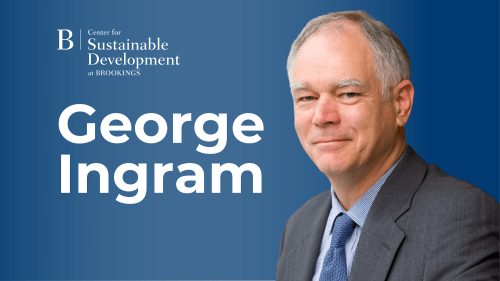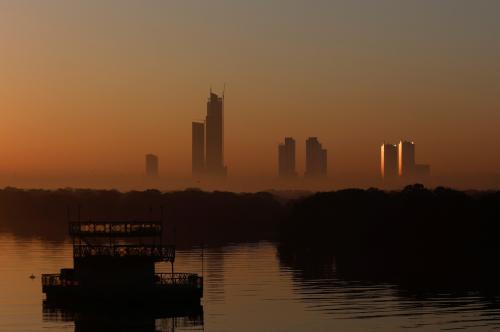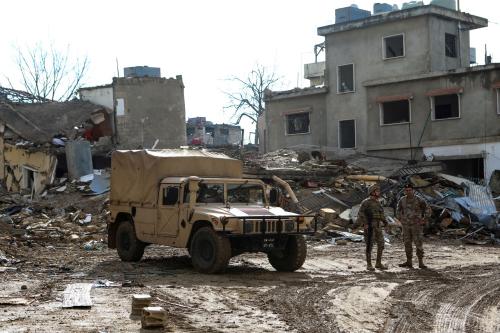Editors’ Note: Brookings senior fellow Kenneth M. Pollack traveled to Iraq from March 9 to March 19 with Michael Knights of the Washington Institute for Near East Policy. The trip was sponsored in part by the Atlantic Council’s Task Force on the Future of Iraq. They had extensive meetings in Baghdad, Sulaymaniyyah, and Irbil with Iraqi, Kurdish, American, and British officials. This is the first of a three-part survey on the situation in Iraq. (Read the second post here and the third here.)
The military campaign is gathering steam
The U.S.-led coalition’s military campaign to “defeat” Da’esh (the Arabic acronym for ISIS) appears to be going better than is widely realized. The media has begun to pick up on this, but so far, the accounts do not seem to do it justice. The coalition has trained (or retrained) six Iraqi brigades, typically called the “Mosul Counterattack Brigades” or just the “Counterattack Brigades.” It was these formations that did most of the work at Ramadi and several are being shifted north to begin the Mosul operation. They are performing considerably better than other Iraqi brigades, a fact that is increasingly understood throughout the Iraqi government, boosting their prestige and the influence of the United States.
Coalition air power is hitting Da’esh much harder than in the past, not because any additional assets have been allocated, but because the American military leadership has been able to convince the Iraqis to forego copious on-call fire support and plastering the ground in front of Iraqi formations with air strikes before even the smallest Iraqi offensive. As a result, U.S. commanders have been able to direct far more strike sorties against deliberate targets such as Da’esh’s oil, money, bomb-making plants, transportation, and leadership targets. Moreover, the coalition has been able to employ Special Operations Forces (SOF) more aggressively and creatively than in the past, achieving some impressive synergies with the air and conventional ground campaigns.
The United States has also put some additional assets into the fight in Iraq, such as the tube artillery deployed to Makhmur and advanced multiple-rocket launcher systems that have been employed elsewhere in Iraq. As the press is already reporting, there are probably about 5,000 American troops in Iraq—not the 3,800 the U.S. government typically claims—and they are far more involved in combat operations than most recognize. Moreover, expect the U.S. military to ask for both more assets and more permissive rules of engagement to enable them to provide greater direct support to Iraqi forces in the field as part of the operations against Mosul.
[T]here is growing evidence to suggest that Da’esh is taking a beating.
As a result, there is growing evidence to suggest that Da’esh is taking a beating. Da’esh has not mounted a successful offensive operation essentially since Ramadi and Palmyra in May 2015. Moreover, whenever they have tried during the past six months, the attack has been smashed quickly and efficiently, typically suffering 60 percent or higher casualties (a historically catastrophic rate). There are indications that the morale of Da’esh fighters in Fallujah and Mosul is growing somewhat fragile, with Da’esh commanders worrying that their troops will neither attack nor defend as strenuously as they once had. As further evidence of problems, Da’esh is increasingly shifting both new recruits and experienced cadre from Iraq-Syria to Libya.
In contrast, the sense of momentum and coming victory by the coalition is also encouraging more and more Sunni tribesman to abandon Da’esh—or simply find the courage to defy them—and join Sunni Popular Mobilization Forces (Hashd ash-Shaabi, or Hashd in Arabic). American military and embassy personnel reported that since the fall of Ramadi, several thousand had shown up for training from Anbari tribes. They described it as a sudden and dramatic change from the prior 18 months.
The Iraqi high command remains very problematic, but even there the coalition command team appears to have made some noteworthy progress. The coalition seems to have more say in which Iraqi commands are entrusted to lead key ground operations, and has been able to inject some greater alacrity into the typically ponderous Iraqi military leadership. Of course, this last problem has been greatly ameliorated during the campaign along the Euphrates valley because Da’esh’s defenses are crumbling west of Ramadi. Still, Iraq’s command and control problems may be the most important impediments to further progress, at least at present.
Baghdad’s announcement that the liberation of Mosul has begun is a bit premature.
Baghdad’s announcement that the liberation of Mosul has begun is a bit premature. As has been widely reported, Iraqi forces are pushing toward Qayyarah West airfield, west of the Tigris river south of Mosul. Qayyarah West can then serve as a logistical hub and staging base for a more deliberate assault toward Mosul somewhat later. Assuming that the Iraqis and the coalition continue to prioritize the liberation of Mosul over finishing off the Da’esh strongholds along the Euphrates valley, and barring some unforeseen development that hamstrings the Iraqis or revives Da’esh’s fortunes, it is entirely possible that Mosul could fall in the next 6 to 12 months.
Credit for this progress should go to Lt. General Sean MacFarland, the commander of Operation Inherent Resolve, and his team, who have taken a disorganized and fragmented effort and turned it into something starting to resemble a well-oiled machine. MacFarland and his team, many of them seasoned Iraq veterans, are demonstrating how much can be achieved even with relatively modest U.S. and Western forces, and even when you are forced to “punch with somebody else’s fists,” as they say.
The persistent danger of catastrophic success
While the military campaign against Da’esh is starting to move ahead smartly, the civilian side of the effort is not keeping pace. This is deeply problematic because, as I warned over a year ago, even decisive military success against Da’esh is likely to prove ephemeral if there is no plan (nor any effort to implement such a plan) to create a political context where tactical military victories can be translated into enduring, political achievements. Indeed, the situation could actually be worse under those circumstances because we will have removed the common threat of Da’esh, which is one of the few forces currently holding various Iraqi groups together.
[E]ven decisive military success against Da’esh is likely to prove ephemeral if there is no plan…to create a political context where tactical military victories can be translated into enduring, political achievements.
First off, there does not appear to be plan for the stabilization and reconstruction of Mosul after it falls. In U.S. military parlance, these tasks are part of Phase IV of any campaign plan. Infamously, the United States did not have an articulated, resourced Phase IV to the operations plan for the invasion of Iraq in 2003, hence the catastrophic failure of the post-invasion occupation for the next three years. In 2011, the United States effectively had no Phase IV plan for the withdrawal of U.S. forces from Iraq either. Arguably, such a plan existed on the military side, but it was never implemented by the civilian side once the military withdrew. Either way, Iraq’s slide back into civil war by mid-2014 was the inevitable result of this parallel failure. Today, we are facing another massive military operation (the fall of Mosul and the final “defeat” of Da’esh in Iraq) and once again we do not yet have a Phase IV plan. And while we still have some time, building such a plan, resourcing it, and preparing to implement it are such monumental tasks that they should have begun six months ago.
This is especially problematic because the intelligence suggesting the fragility of Da’esh’s forces in Mosul—and the convergence of all manner of Iraqi, coalition and regional forces around Mosul—raise the possibility that Da’esh forces there might implode or flee before the coalition is ready to take the city deliberately. That would trigger a stampede of various groups claiming parts or all of Mosul that could lead to all kinds of internecine conflict. In these circumstances, the United States would have to try to get the Iraqis to quickly improvise a plan. Given the difficulty of getting the Iraqi military (and civilian) leadership either to improvise or to move quickly in small operations, the prospect that we would need them to do both for a massive undertaking like Mosul seems like a disaster waiting to happen. Having those plans and everything necessary to implement them must be a top priority, lest the “liberation” of Mosul turn into yet another American-Iraqi fiasco.
Stabilizing Iraq is a lesser task included in the current mission, meaning that it often gets short shrift for attention and resources.
Moreover, it is important to keep in mind that the military campaign remains solely aimed at Da’esh. Stabilizing Iraq is a lesser task included in the current mission, meaning that it often gets short shrift for attention and resources. As I have repeatedly argued elsewhere, the history of civil wars demonstrates that this is a huge mistake. It could easily produce the collapse of Da’esh and its replacement by “son of Da’esh” which will almost certainly be even worse than Da’esh (just as Da’esh is the “son of” al-Qaida and even worse than it) because we will not have addressed the circumstances that gave rise to Da’esh in Iraq and Syria in the first place.
The militia question
Another critical political-military problem is the question of the Hashd ash-Shaabi. Prime Minister Haider al-Abadi is clearly well aware of both the importance of the Hashd (they were critical to halting the Da’esh offensive against Baghdad in 2014) as well as their potential to undermine Iraq’s future stability and security if they endure as an Iranian-backed alternative military—an Iraqi Hezbollah. We noted that even key Hashd ash-Shaabi commanders duly intoned that they intend for Hashd personnel to eventually be incorporated into the armed forces, although it is impossible to gauge their sincerity.
The government’s original plan was to start paying the Hashd, and so use the “power of the purse” to gain control over them. Once that was accomplished, Baghdad would eventually demobilize most and integrate the rest into the Iraqi armed forces. Unfortunately, Iraq’s financial crisis has made that impossible. Instead, the government is now considering conscription as a way to handle the problem. The idea is that if there is universal conscription, all of the members of the Hashd will eventually be conscripted and placed immediately under the armed forces.
Universal conscription could be hugely beneficial to Iraq in many ways. At the most basic level, universal conscription would mitigate Iraq’s massive (and growing) problem with youth unemployment. It would allow Iraq to build an integrated, non-sectarian military force that could be accepted by the populace and help to bind it together. More than that, as the Israelis demonstrated beginning in 1948, because military service is such a powerful method of socialization, conscription would allow Baghdad to build a new Iraqi political culture to heal the rifts that have occurred since 2005 (and to a lesser extent since 1991). Indeed, some Iraqi military personnel are actively exploring the Israeli model to think about how Iraq might use conscription to help heal the rifts and build a new, unified Iraqi society.
It is not clear, however, if conscription will solve the problem of the Hashd. First, Iran or its Iraqi allies may block it, although this too is far from certain. Nevertheless, the Iranians or key leaders of the Hashd may conclude that it is just too useful to them to have the Hashd as an independent military responsive to them as a check on Baghdad and the United States. Both Tehran and its Iraqi friends wield considerable influence in Iraq, although that influence has waned somewhat as a result of the greater and more successful U.S. effort (see below).
Second, even if the Iranians or the Hashd leadership chooses not to block conscription, they might insist on exemptions for the Hashd personnel—or that the Hashd remain as a standing force and get its share of new recruits. Finally, Iraq is probably still several years away from being able to implement conscription, and the Hashd could do a lot of damage between then and now, including institutionalizing itself in ways that might make it much harder to eliminate when and if conscription ever materializes. Thus, conscription is a great idea and it could be a solution to the problem of the Hashd, but there is no certainty it will be.
Ephemeral or durable?
The purely military aspects of the campaign appear to be progressing well, finally beginning to hit on all cylinders. A superb American command team has found important news to greatly improve the impact of U.S. air power, SOF, and direct support. The Iraqi Army has been partly rebuilt, and those units retrained and re-equipped by the coalition are performing noticeably better than the others. While the coalition’s military power is slowly building, the increasing pressure on Da’esh is diminishing its capacity to resist.
Unfortunately, as has been a trademark of American involvement with Iraq at least since 2003 (and arguably since 1991), military success is not being matched with the commensurate political-economic efforts that will ultimately determine whether battlefield successes are translated into lasting achievements. In particular, the absence of developed and resourced plans to deal with post-conflict stabilization and reconstruction, and the lingering question regarding the future status of the militias raise huge questions about whether these victories will prove as ephemeral as America’s many past triumphs in Iraq.
The Brookings Institution is committed to quality, independence, and impact.
We are supported by a diverse array of funders. In line with our values and policies, each Brookings publication represents the sole views of its author(s).



Commentary
Iraq Situation Report, Part I: The military campaign against ISIS
March 28, 2016